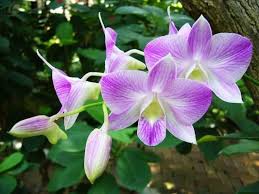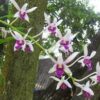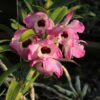# Outstanding Features of Notable Dendrobium Varieties

Dendrobium orchids are among the most diverse and widely cultivated orchids globally. Known for their striking beauty and varied forms, these orchids have captured the hearts of plant enthusiasts and collectors alike. With over 1,800 species and countless hybrids, each Dendrobium variety offers unique characteristics and features that set it apart. In this article, we will explore some of the most notable Dendrobium varieties, highlighting their outstanding features, growth habits, and care requirements.
## Understanding Dendrobium Orchids
### The Dendrobium Genus
Dendrobium is one of the largest genera in the Orchidaceae family, encompassing a wide array of species found primarily in tropical and subtropical regions of Asia, Australia, and the Pacific Islands. The genus is known for its adaptability, thriving as epiphytes (growing on trees), lithophytes (growing on rocks), and terrestrial plants. Their growth habits vary significantly among species, making them a versatile choice for growers.
### Characteristics of Dendrobium Orchids
– **Growth Forms**: Dendrobium orchids exhibit a range of growth forms, including upright, climbing, and cascading habits. This diversity allows them to be grown in various settings, from hanging baskets to upright pots.
– **Pseudobulbs**: Many Dendrobiums have pseudobulbs, which are swollen stems that store water and nutrients. These structures are crucial for the plant’s survival during dry periods.
– **Flowering Cycles**: Dendrobiums typically bloom once a year, with some varieties exhibiting a long blooming period. The flowers come in various colors, shapes, and sizes, making them highly sought after for ornamental use.
## Notable Dendrobium Varieties and Their Features
### 1. Dendrobium Nobile
**Overview**: Dendrobium Nobile is one of the most popular and widely cultivated species within the Dendrobium genus. Known for its beautiful and fragrant flowers, it has become a favorite among orchid enthusiasts.
**Outstanding Features**:
– **Pseudobulbs**: Dendrobium Nobile produces elongated pseudobulbs that can grow up to 12 inches long. These structures store water and nutrients, making the plant more resilient during dry spells.
– **Fragrant Flowers**: The flowers of Dendrobium Nobile are known for their delightful fragrance, with colors ranging from white to lavender and pink. The blooms can last for several weeks, adding a lovely scent to any environment.
– **Seasonal Growth**: This species typically blooms in late winter to early spring, making it a great addition to gardens during the transition into warmer months.
**Care Requirements**:
– **Light**: Dendrobium Nobile prefers bright, indirect light. A south or east-facing window is ideal for optimal growth.
– **Watering**: Water the plant thoroughly during the growing season (spring and summer), allowing the medium to dry slightly between waterings. Reduce watering during the dormant period (fall and winter).
– **Fertilization**: Apply a balanced orchid fertilizer every two to four weeks during the growing season to support healthy growth and blooming.
### 2. Dendrobium Phalaenopsis
**Overview**: Dendrobium Phalaenopsis, also known as the “Phalaenopsis Dendrobium,” is a hybrid species that resembles the popular Phalaenopsis orchid. It features beautiful, large flowers and is well-suited for indoor cultivation.
**Outstanding Features**:
– **Large, Showy Flowers**: The flowers of Dendrobium Phalaenopsis are characterized by their size and vibrant colors, including shades of purple, pink, and white. The large blooms can last for several weeks, making them an attractive focal point.
– **Compact Growth Habit**: This hybrid typically grows to about 12-24 inches tall, making it an excellent choice for smaller spaces.
– **Ease of Care**: Dendrobium Phalaenopsis is relatively easy to care for, making it suitable for beginners. It is less demanding in terms of light and humidity compared to other Dendrobium species.
**Care Requirements**:
– **Light**: Provide bright, indirect light for optimal growth. Avoid direct sunlight, as it can scorch the leaves.
– **Watering**: Water when the top inch of the potting medium feels dry. Maintain a regular watering schedule during the growing season and reduce frequency in the dormant period.
– **Humidity**: This species prefers humidity levels around 50-70%. Using a humidity tray or misting the leaves can help maintain adequate moisture.
### 3. Dendrobium Australian Species (Dendrobium speciosum)
**Overview**: Dendrobium speciosum, commonly known as the “Rock Orchid,” is native to Australia. This species is renowned for its striking clusters of flowers and robust growth habit.
**Outstanding Features**:
– **Clustered Blooms**: Dendrobium speciosum produces clusters of fragrant flowers, often in shades of yellow, white, or green. The blooms can appear in profusion, creating a stunning display.
– **Versatile Growth**: This species can be grown as an epiphyte or in pots, making it adaptable to various gardening setups.
– **Strong and Resilient**: Dendrobium speciosum is known for its hardiness and ability to withstand varying environmental conditions, making it an excellent choice for both novice and experienced growers.
**Care Requirements**:
– **Light**: Provide bright light, ideally with some direct morning sunlight. This will encourage healthy growth and abundant flowering.
– **Watering**: Allow the medium to dry slightly between waterings. This species is tolerant of brief dry periods.
– **Temperature**: Dendrobium speciosum thrives in a wide range of temperatures, making it suitable for various climates.
### 4. Dendrobium Lindleyi
**Overview**: Dendrobium Lindleyi, also known as “Dendrobium aggregatum,” is a species native to Southeast Asia. This orchid is prized for its unique growth habit and beautiful flowers.
**Outstanding Features**:
– **Cascading Growth**: Dendrobium Lindleyi has a distinctive cascading growth habit, with long canes that can reach up to 2 feet. This makes it an attractive choice for hanging baskets.
– **Bright Yellow Flowers**: The flowers of Dendrobium Lindleyi are small but vibrant, often appearing in clusters. Their bright yellow color adds a cheerful touch to any space.
– **Hardy and Resilient**: This species is known for its ability to adapt to varying conditions and can tolerate dry spells better than many other Dendrobium varieties.
**Care Requirements**:
– **Light**: Place Dendrobium Lindleyi in bright, indirect light. It can tolerate some direct sunlight, particularly in the morning.
– **Watering**: Water the plant thoroughly, allowing the medium to dry slightly between waterings. Reduce watering during the dormant period.
– **Fertilization**: Apply a balanced fertilizer every four weeks during the growing season to promote healthy growth and blooming.
### 5. Dendrobium Kingianum
**Overview**: Dendrobium Kingianum, also known as the “Sydney Rock Orchid,” is a native Australian species valued for its stunning flowers and compact size.
**Outstanding Features**:
– **Small, Vibrant Flowers**: This species produces small, fragrant flowers in shades of white, pink, and lavender. The blooms are often produced in clusters, creating a lovely display.
– **Compact Size**: Dendrobium Kingianum typically grows to about 12-18 inches tall, making it suitable for small spaces and indoor environments.
– **Cold Tolerance**: This species is relatively cold-tolerant compared to other Dendrobiums, making it a great choice for gardeners in cooler climates.
**Care Requirements**:
– **Light**: Provide bright, indirect light, similar to other Dendrobium species. Avoid direct sunlight to prevent leaf burn.
– **Watering**: Allow the potting medium to dry slightly between waterings, particularly during the winter months.
– **Humidity**: Maintain humidity levels around 40-60% for optimal growth and flowering.
### 6. Dendrobium Cuthbertsonii
**Overview**: Dendrobium Cuthbertsonii is a unique species native to New Guinea, known for its unusual growth habits and vibrant flowers.
**Outstanding Features**:
– **Unique Growth**: This species features tall canes that can reach up to 3 feet, making it a striking addition to any orchid collection.
– **Vivid Orange Flowers**: Dendrobium Cuthbertsonii produces large, vibrant orange flowers that stand out against the green foliage. The blooms have a delightful fragrance.
– **Adaptability**: This species can be grown in various settings, including pots and hanging baskets, making it versatile for different gardening styles.
**Care Requirements**:
– **Light**: Provide bright, filtered light, avoiding harsh direct sunlight that can damage the leaves.
– **Watering**: Water regularly, allowing the medium to dry slightly between waterings. This species thrives in a well-draining mix.
– **Temperature**: Dendrobium Cuthbertsonii prefers moderate temperatures and can tolerate cooler conditions compared to many other Dendrobium varieties.
### 7. Dendrobium Senile
**Overview**: Dendrobium senile, commonly referred to as the “Dendrobium anosum,” is a distinctive species known for its unique flower shape and rich history in orchid cultivation.
**Outstanding Features**:
– **Striking, Unique Flowers**: Dendrobium senile produces unusual, elongated
flowers with a distinctive shape, often in shades of purple, pink, and white. The blooms have a pleasant fragrance, attracting pollinators.
– **Compact Growth**: This species typically grows to about 12-18 inches, making it suitable for smaller spaces and indoor collections.
– **Cultural Significance**: Dendrobium senile is often used in traditional ceremonies in its native regions, highlighting its cultural importance.
**Care Requirements**:
– **Light**: Provide bright, indirect light to encourage healthy growth and flowering. Avoid direct sunlight to prevent leaf burn.
– **Watering**: Water thoroughly, allowing the medium to dry slightly between waterings. Maintain regular watering during the growing season.
– **Humidity**: This species thrives in humid conditions, making it ideal for growing in terrariums or humidified environments.
## Conclusion
Dendrobium orchids offer a rich diversity of species, each with its unique features and charm. From the fragrant blooms of Dendrobium Nobile to the stunning clusters of Dendrobium speciosum, these orchids provide endless possibilities for enthusiasts and collectors. Understanding the specific care requirements and characteristics of each variety is crucial for successful cultivation and enjoyment. Whether you are a seasoned grower or a beginner, incorporating Dendrobium orchids into your collection can bring beauty, elegance, and a touch of nature to your living space.

